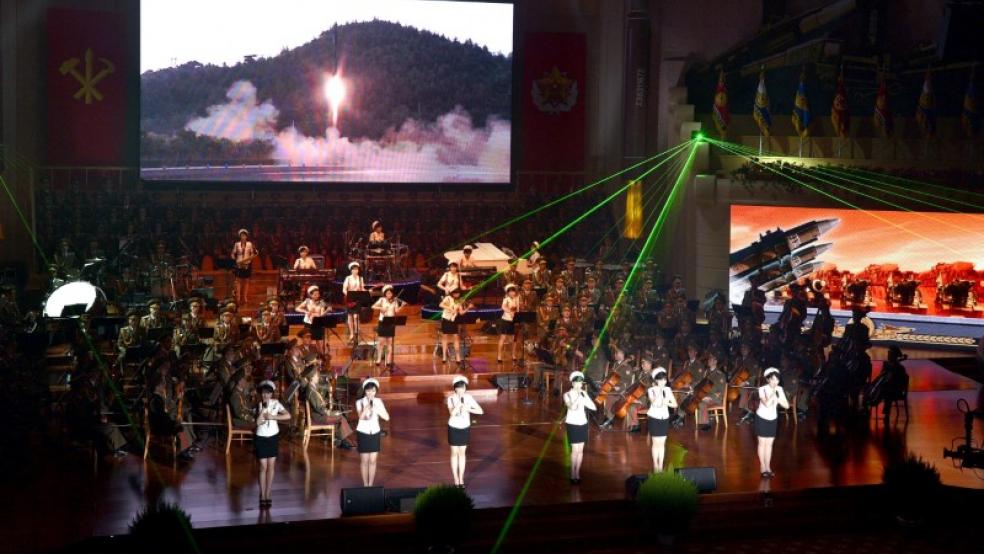In an effort to calm the increasingly dangerous standoff between North Korea on one side and the U.S. and South Korea on the other, China on Wednesday proposed a solution aimed at a long-term reduction in tensions: Pyongyang puts its nuclear and missile programs on ice, while Washington and Seoul halt joint military exercises.
Related: The US Navy’s $13 Billion Answer to China and Russia
China appears to be a peacemaker, but it may be running scared to the bargaining table for two reasons. While the repressive dynasty that has ruled North Korea since the 1950s could not have remained in power without Beijing’s support, the current leader, Kim Jong-un, is acting more unstable than his predecessor and must be reined in before he ignites a new war on the Korean Peninsula.
The second reason is an acronym: THAAD.
That stands for Terminal High Altitude Aerial Defense – the $1.6 billion-per-unit, anti-missile defense system that the U.S. began positioning in South Korea this week after North Korea fired four missiles on Monday said to be aimed at American bases in Japan. The missiles were described by South Korean military and intelligence officials as a version of the Scud surface-to-surface ballistic missile. All four missiles fell into the Sea of Japan, but some came as close as 190 miles from the coast, according to Reuters.
One THAAD battery includes six truck-mounted launchers, 49 interceptors and AN/TPY-2 radar, according to DefenseNews. Raytheon, which builds the radar system for the unit in conjunction with Lockheed Martin, says it has “a record of flawless performance against all classes of ballistic missiles.”
But the radar’s accuracy and detection may be what China fears as much as the disruption of the balance of forces on the peninsula. The radar’s coverage could extend beyond North Korea and into China. In an article written last year, when THAAD deployment was being considered, DefenseNews quoted a Chinese defense analyst as saying: “THAAD deployment could bring a severe shock to the security status quo that exists between China and the U.S., as well as with Russia.”
Related: US Navy Sends a Powerful Message to Beijing in the South China Sea
South Korea has been pushing for deployment of THAAD systems because its current missile defenses allow for interception at an altitude of only 9.3 miles. THAAD would increase that range to between 24.8 and 93.2 miles, and with both systems in place, there would be a double deterrent, the Seoul-based think tank Korea Defense & Security Forum told DefenseNews.
Chinese Foreign Minister Wang Yi on Wednesday said that Beijing’s intention was “to flash the red light and apply brakes” to the situation, The New York Times reported. But as the Times pointed out, a 2015 proposal by North Korea for a moratorium on nuclear tests in exchange for a cancellation of joint U.S.-South Korea military exercises, which Pyongyang has called a prelude for invasion, went nowhere.
Beijing’s concern about Kim Jong-un may be more heightened than ever after the assassination of his estranged half-brother Kim Jong-nam in Kuala Lumpur and the execution of five of the North Korean leader’s top security officials with anti-aircraft guns because they “enraged” him with false reports.
Malaysian officials have implicated North Korean agents in the bizarre killing of Kim Jong-nam; Malaysian citizens are not being allowed to leave North Korea; North Koreans are not being allowed to leave Malaysia; and a video was posted on Tuesday in which a young man claiming to be Kim Jong-nam’s son says he and his mother and sister are in hiding.
Related: North Korea’s Missile Test Leaves Trump with Three Options
The Times quoted Foreign Minister Wang as saying of the confrontation between North Korea and the U.S.-South Korea: “The two sides are like two accelerating trains coming toward each other, and neither side is willing to give way. The question is: Are both sides really prepared for a head-on collision?”





